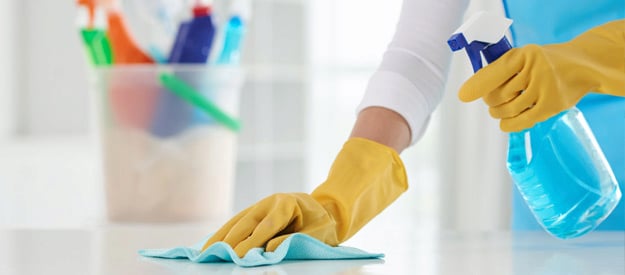The two-step cleaning process
According to the ADA Infection Control Guidelines, environmental surfaces outside the 'contaminated zone' must be wiped down with a detergent and warm water. However, further studies[i] have shown that healthcare practitioners should be abiding by a two-step cleaning process; firstly cleaning and secondly, the use of a disinfectant. Abiding by this process will keep your healthcare facility up-to-date with all guidelines and standards, therefore decreasing the chance of cross-contamination.
Many healthcare facilities typically use a disinfectant for their cleaning and disinfectant steps, which may promote the development of immune bacterial strains. The two-step process avoids the development of antibiotic resistance by eliminating all bacteria strains. Therefore, it is recommended to use a universal disinfectant wipe on surfaces with minimal debris (such as Clinell wipes and V- wipes from Whiteley) which contains a disinfectant and detergent to encapsulate the two-step process, effectively eliminating all strains of bacteria, therefore minimizing the risk of cross infection.
Why the two-step cleaning process?
“Clean first before you disinfect. Germs can hide underneath dirt and other material on surfaces where they are not affected by the disinfectant. Dirt and organic material can also reduce the germ-killing ability of some disinfectants.” - U.S. Environmental Protection Agency (EPA)[ii].
According to the EPA disinfecting without cleaning (detergent) the area causes debris to desiccate, making it harder to clean from the surface. The use of a two-step process increases the chances of removing all micro-organisms compared to just disinfecting the surface. Examples of a 2 step-process are a neutral detergent wipe and then use a liquid disinfectant to eliminate stains of micro-organisms or for convenience, use a universal wipe compromising detergent and disinfectant components.
According to a study by the American Journal of Infection Control[iii] one-step solution wipes containing detergent and disinfectant properties, increases the compliance of Infection Control practices and results in less personnel time – reducing surgery costs. Surgeries should consider a universal wipe for their surgeries to use on sensitive surfaces (rubber, plastic etc.), non-sensitive surfaces and surfaces with a low level of debris to effectively encapsulate a two-step process with a universal wipe. However, there is also an option of using both separate detergent and disinfectant wipes for when surfaces are contaminated with a high level of debris (blood, fluids, dirt etc) to efficiently eliminate micro-organisms (Clinicare Neutral detergent wipes and Hospital Grade Disinfectant wipes).
The use of Neutral Detergent
A neutral detergent wipe with a pH level of 7 will minimize the corrosive effects on surfaces. There are many brands that have effective detergent wipes; these include Clinicare's neutral wipes and Speedy Clean Wipes. Detergent wipes should be alcohol-free (as of which both wipes mentioned are) and consist of a neutral pH to avoid corrosive effects. Clinicare's neutral detergent wipes contain an active pH neutral surfactant (acting as a detergent component), which lowers the surface tension between two liquids or two liquids and a solid to efficiently clean all debris from the surface.
The use of Disinfectants
In relation to disinfectants, the greater the pH, the more effective the disinfectant; however with a higher pH there is also a higher risk of corrosion (on sensitive surfaces) and skin irritation to occur. Due to this, the ADA Guidelines for Infection Control suggest using gloves when disinfecting surfaces, and does not recommend the use of spray bottles - as the exposure to aerosol droplets and the effects of inhaling these droplets may be harmful.
Clinicare offers Hospital Grade Disinfectant towelettes which contain Benzalkonium Chloride and Isoprophyl Alcohol (18%) (Isopropyl alcohol has been proven to be effective in destroying multiple micro-organisms[iv]) and have a high water concentration which minimizes surface corrosion.
Another option is Clinell sanitizing wipes. In regards to Clinell wipes, this sanitizing and universal range offer convenience featuring a patented antimicrobial formula, comprising of both a disinfectant and detergent based on Benzalkonium Chloride. This means Clinell can now present a one-step wipe containing a detergent and disinfectant property, that is compliant to Infection control protocols and reduces time to clean – reducing surgery costs.
In summary, the two-step cleaning process is an effective way to clean within your surgery. However, this is a time consuming process and therefore it is recommended to use a one-step process (disinfectant and detergent wipe in one) on low level debris contaminated surfaces, minimizing time to clean with the same efficacy.
Surfaces with a high level of debris should be treated with extra care through the two-step cleaning process. If surfaces have a high level of debris, cleaning before disinfecting is vital for the effective elimination of multiple micro-organisms which may affect your staff, patients and your healthcare practice.
REFERENCES
[i]https://www.cdc.gov/oralhealth/infectioncontrol/questions/cleaning-disinfecting-environmental-surfaces.html
[ii] http://cleancoretech.com/when-cleaning-and-disinfecting-we-clean-first-and-then-disinfect/
[iii]http://www.vericlean.com.au/images/pdf/whitepapers/I_Disinfectant_Wipes_Value_vs_Std_Cloths_Weimken_AJIC_2014.pdf
[iv] https://www.hunker.com/12309315/what-organisms-does-isopropyl-alcohol-kill
.png)

